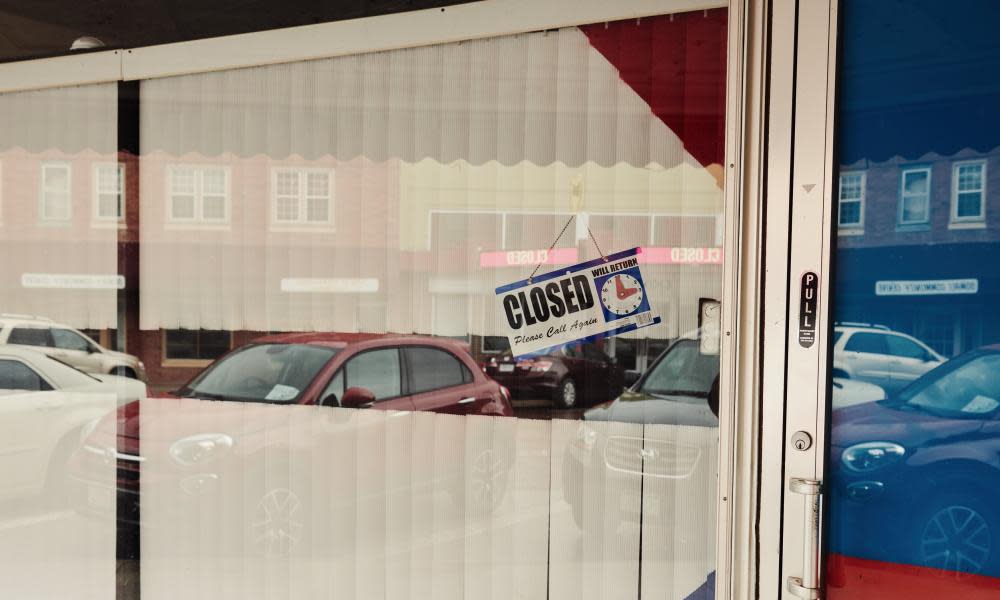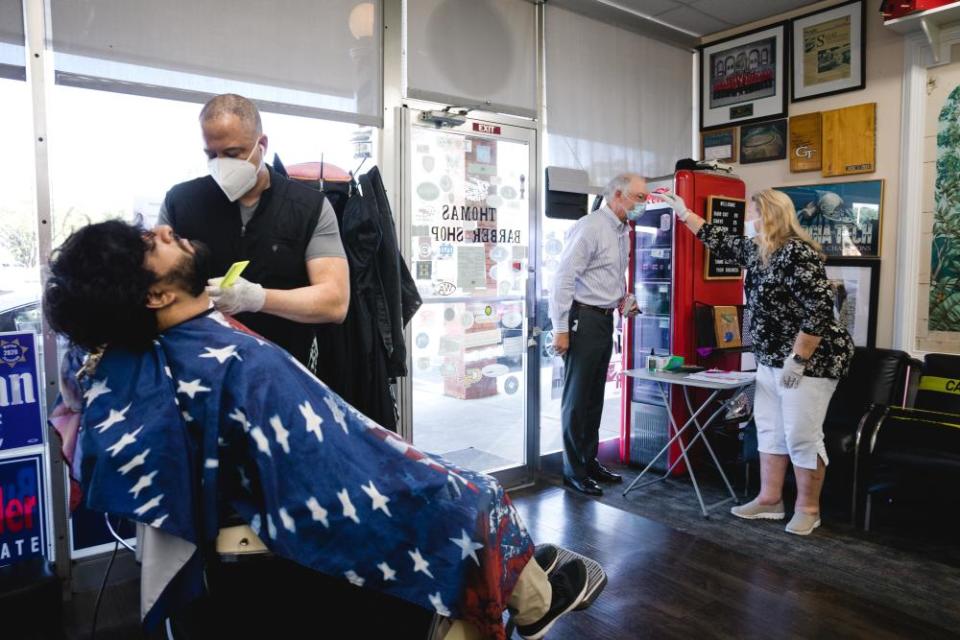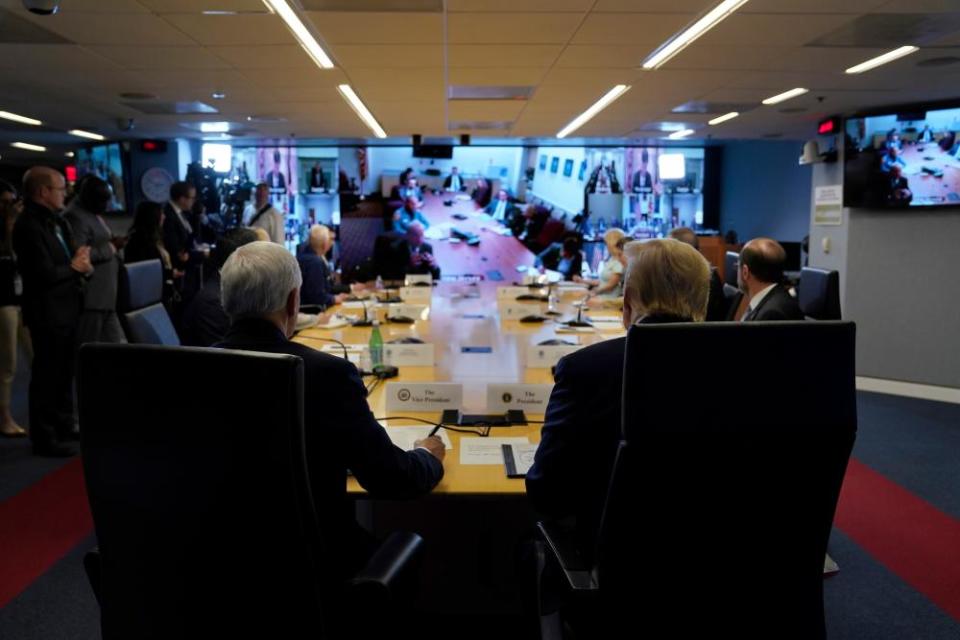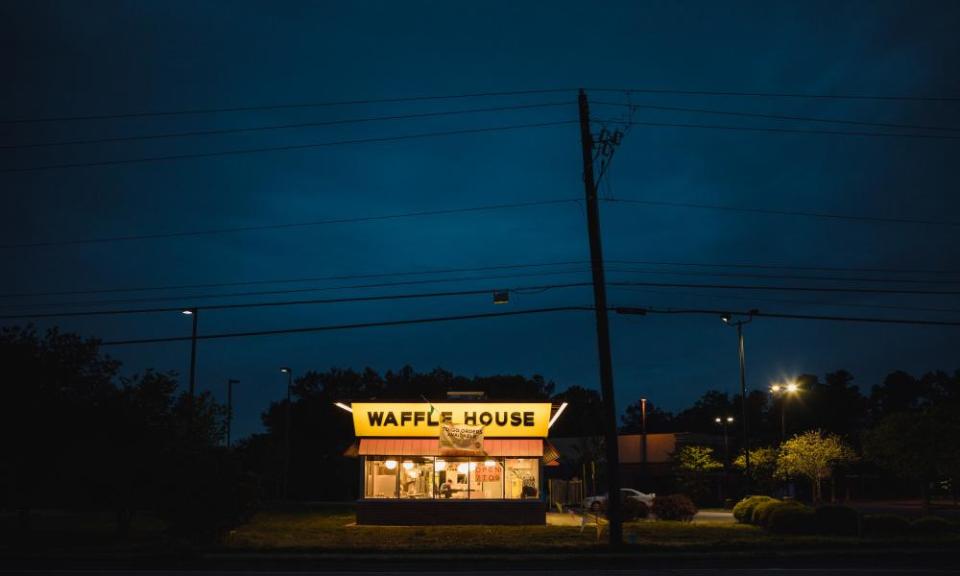How will the US reopen? Slowly, bit by bit, but we may never return to 'normal'

“We’re ready to open up the state to get back to work,” Kathryn Goppelt told reporters last weekend as protesters marched on the Louisiana capitol in Baton Rouge calling for an end to the coronavirus pandemic lockdowns.
Goppelt is one of thousands of people who have taken to the streets in Michigan, Wisconsin, California and other states demanding an end to stay-at-home orders that have brought the US economy to a standstill and so far cost 26m jobs.
On Tuesday Donald Trump rolled out a new blueprint, dubbed Opening up America Again, that included ramping up testing and a partnership with drugstore chains to expand access to tests nationwide.
“We are doing everything in our power to heal the sick and to gradually reopen our nation and to safely get our people back to work,” Trump said. “There is a hunger for getting our country back, and it is happening.”
But the real truth is that the reopening of America will happen slowly, bit by bit, state by state, city by city, business by business, building by building. Corporate America will have as large a say as Trump as to when things will really reopen. So will the state governors. And as the US contemplates getting back to normal, it is also becoming clear our definition of “normal” may have changed forever.
Several states have now begun unwinding the quarantine initiatives introduced as the pandemic hit the US.
Texas started reopening this week. Georgia’s stay-at-home order expires on 30 April but Governor Brian Kemp has already allowed some businesses, including hair salons, gyms, tattoo parlors and bowling alleys to reopen. Alaska, Oklahoma, Colorado, Tennessee and some other states are also relaxing their quarantine orders or preparing to. Big business is watching carefully and some – notably Boeing – have started up again. But big business is not yet rushing to open its doors in a post Covid-19 world.
Some 49% of CFOs see remote working as a permanent solution for some workers
Joanna Daly, vice-president of human resources at IBM, said she has never been busier. With 350,000 employees across 170 countries IBM has witnessed firsthand the global response to the pandemic and is taking a cautious, case-by-case approach to opening its own offices. Some 95% of its staff are now working from home.
States can begin to lift stay-at-home orders, she said. “But that doesn’t mean we will immediately return to the workplace.”
IBM has set up a set of global standards that includes governments and states lifting those orders, but also looks at the clinical data in the community and individual workplaces.

“Workplaces weren’t designed for an environment that requires social distancing. There is a lot of detail going into redesigning the workplace, making changes, decisions, so that the workplace is one that is safe for people to come back to.”
The company is looking at office layouts, removing desks that are too close together, visual reminders to keep your distance, rethinking bathrooms, cafeterias, reassessing cleaning. “We are entering a workplace where we will have to behave differently, move differently, we have to be more aware.”
IBM’s experience tallies with the wider business community. A PriceWaterHouseCoopers survey found 77% of US chief financial officers (CFOs) are anticipating changing workplace safety measures upon returning to on-site work and 65% anticipate reconfiguring work sites to promote physical distancing.
The very nature of work-life is being rethought: some 49% of CFOs see remote working as a permanent solution for some workers.
A widespread reopening will have to take all these factors into account. Country by city, building by building, job by job. A federal or local order to reopen will be just one part of this incredibly complex puzzle and all these changes will take time.
There are plenty of plans for reopening but one of the most often quoted is from the American Enterprise Institute co-authored by Scott Gottlieb, a physician and former commissioner of the Food and Drug Administration. Trump’s plan seems to be a slightly watered down version of the AEI’s. The AEI roadmap offers a three-phase plan to reopening:
Phase I (the phase we are currently in) focuses on using stay-at-home orders and the closure of businesses and public spaces to slow the spread of Covid-19.
Phase II starts the reopening in a state-by-state basis, “When they are able to safely diagnose, treat, and isolate Covid-19 cases and their contacts.” Much of normal life can begin to resume but we would have to maintain physical-distancing measures and more stringent public hygiene measures while protecting the vulnerable.
Phase III and a return to “normal” would come only after testing, tracing, treatment and vaccines become widely available.
The current reopenings come while most of the US is still in phase I and Trump has said those decisions are down to the states.
The pressure to get America working again is intense and growing but opening up too soon, too fast could trigger a second wave of Covid-19 infections, said Saskia Popescu, a hospital epidemiologist in Phoenix, Arizona.
“The sentiment is everybody wants to move forward, of course, but ultimately we in public health and global health security know that it is not something that can be rolled out in one sweeping movement,” Popescu said.
The Business Roundtable, the US’s most powerful business lobby, wrote to Vice-President Mike Pence and all 50 governors last week outlining its recommendations for reopening.

The lobby group, whose members include Amazon, Apple, AT&T, General Motors and Walmart, set out guidelines for different environments including offices, retail, construction and manufacturing. Overall the plan calls for careful control of public spaces, more monitoring and testing of staff, more personal protection equipment and consistent guidelines.
“Americans want to feel confident returning to work and being in public spaces, and employers who operate in multiple states and want to keep their employees and customers safe need the clarity that consistent guidelines provide,” said Joshua Bolten, the president of Business Roundtable.
How can we really gauge how things are going if we can’t get accurate case counts?
Saskia Popescu, a hospital epidemiologist
The problem is that while some suggestions the lobby group made are in the control of businesses (such as limiting the number of people in an office) others are in control of the government –especially testing and monitoring. But so far the US has shown itself to be woefully underprepared to deal with the aftermath of the Covid-19 pandemic as it was to deal with its arrival.
Both Bolten and the Amazon chief, Jeff Bezos, have said widespread testing is needed for businesses to reopen around the world. So far just 5.4m tests have been administered across the US, about 1.6% of the population.
An analysis by Harvard researchers and the health news website Stat found more than half of US states need to significantly step up testing in order to even consider starting to relax stay-at-home orders after 1 May. More worrying still, some of the states now relaxing their quarantine order, including Georgia and Florida, are still well behind the level of testing they will need in order to identify and close down new hotspots.

“How can we really gauge how things are going if we can’t get accurate case counts?” Popescu said.
For all the shouting and hectoring at protests, polls show most people, as well as businesses, agree with the need for caution and are putting safety first.
New York City barber Justin Virgil Gramelspacher left the city shortly after his East Village shop, The Blind Barber, decided to close its doors. “I’m getting a lot of calls from clients. I think when we do open, we are going to be slammed for weeks,” he said. But he said he wouldn’t be comfortable about opening back up anytime soon. “When the governor says we can open up again, I’d do it. Right now, it’s too soon.”
But he worries about what a lengthy closure will mean for the US and for New York City in particular. Neighboring businesses were already struggling with the rent. Social distancing will make it hard for bars and restaurants. The longer closures go on, he worries, the more damage will be done.
“It’s going to be like the Twilight Zone,” he said.

